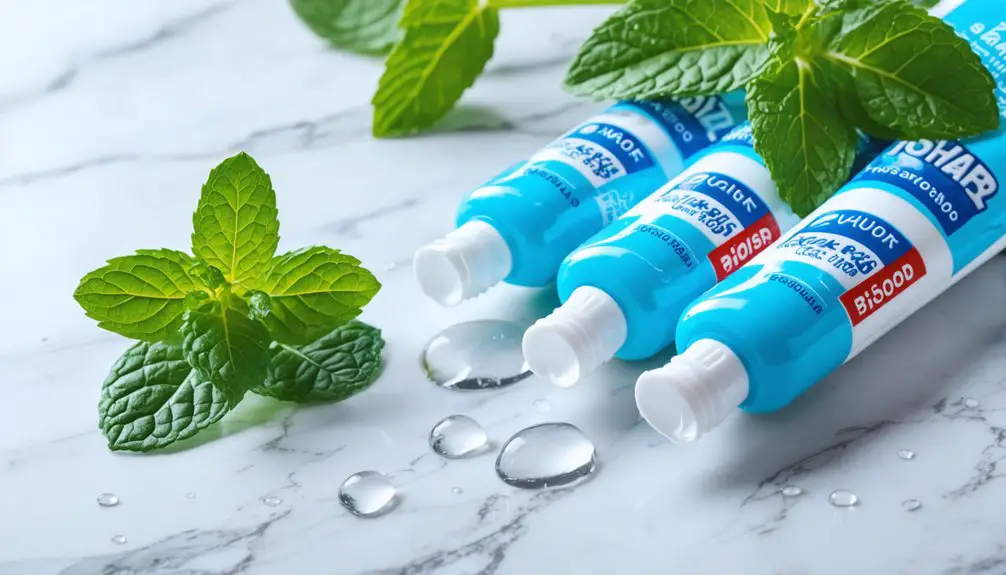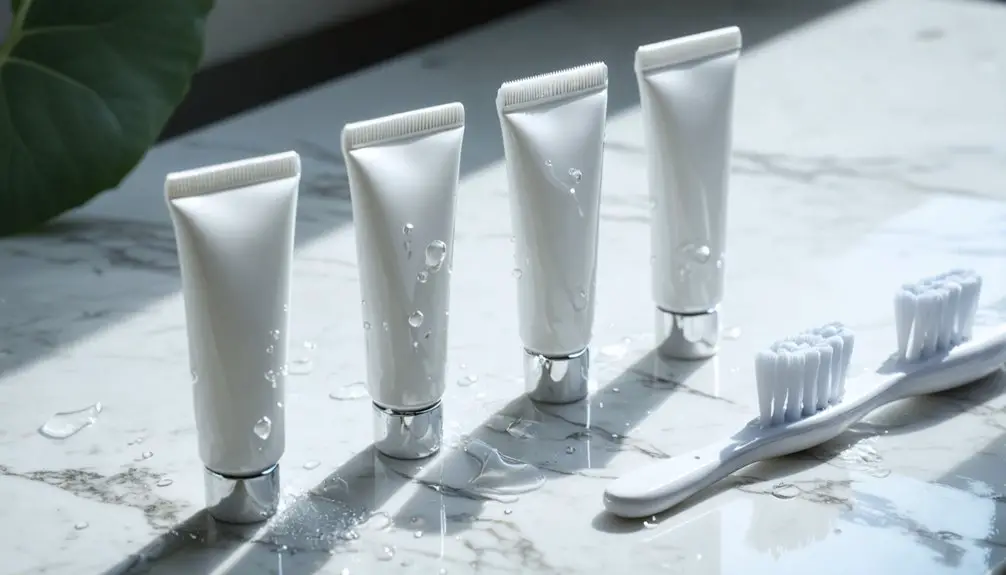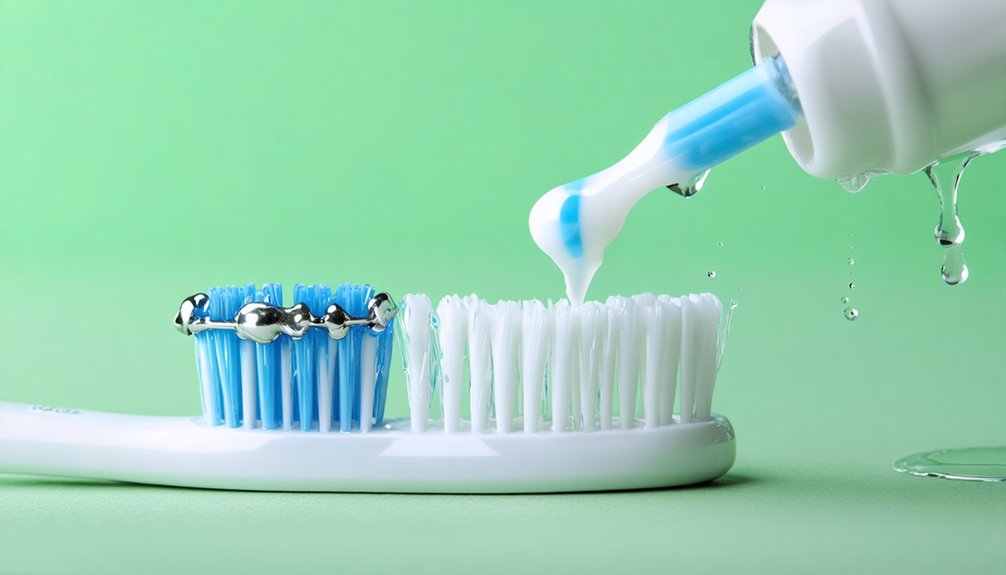You can effectively whiten yellow teeth by choosing toothpaste with proven ingredients like hydrogen peroxide or carbamide peroxide, which penetrate enamel to remove surface and deep stains. For sensitive teeth, opt for formulations containing potassium nitrate and stannous fluoride. Combine gentle abrasives like hydrated silica with protective elements such as fluoride for ideal results. Understanding the science behind whitening agents will help you select the most effective product for your needs.
Key Takeaways
- Choose toothpaste containing hydrogen peroxide or carbamide peroxide, as these ingredients penetrate enamel to remove both surface and deep stains.
- Look for products with gentle abrasives like hydrated silica and baking soda for mechanical stain removal without damaging enamel.
- Consider Sensodyne Pronamel or similar brands if you have sensitive teeth while whitening, as they contain protective ingredients like potassium nitrate.
- Apply whitening toothpaste at night for maximum contact time and effectiveness in stain removal.
- Combine daily whitening toothpaste with professional treatments and avoid staining agents for optimal tooth whitening results.
Understanding the Science Behind Whitening Toothpaste
When it comes to understanding whitening toothpaste’s efficacy, you’ll need to grasp the core chemical mechanisms at work.
The primary whitening mechanisms involve hydrogen peroxide or its derivative, carbamide peroxide, which break down into reactive oxygen species. These molecules achieve enamel penetration, reaching both surface stains and deeper discoloration within your teeth’s structure. Regular exposure to teeth-staining substances like coffee and tobacco creates stubborn chromogens that require targeted treatment.
Hydrogen peroxide and carbamide peroxide create reactive oxygen species, penetrating tooth enamel to target both superficial and deep-set stains.
As these agents interact with stain molecules, they break down complex pigments into smaller, less visible compounds through oxidation. The ideal pH balance must be maintained during whitening to prevent enamel demineralization and potential damage.
While some toothpastes rely on abrasives like silica or activated charcoal to remove surface stains, true bleaching occurs when peroxide-based ingredients reach the dentin layer beneath your enamel.
Understanding these processes helps you select products that address both extrinsic and intrinsic staining for your patients’ specific needs.
Best Whitening Options for Sensitive Teeth
For patients with sensitive teeth, selecting an appropriate whitening toothpaste requires careful consideration of both active ingredients and abrasive levels.
You’ll find excellent sensitivity relief in products like Sensodyne Pronamel Gentle Whitening and Icy Bear Sensitive Toothpaste, which contain proven ingredients such as potassium nitrate and stannous fluoride.
To maximize enamel protection while whitening, look for formulations with hydroxyapatite and low-abrasion agents. Natural ingredients like aloe and chamomile can provide additional soothing benefits for irritated gums. For best results, apply at night and avoid rinsing to allow ingredients to work effectively.
You can recommend Sensodyne Extra Whitening for its balanced approach to stain removal and sensitivity management.
When incorporating whitening toothpaste into a patient’s routine, advise them to monitor their response and adjust usage accordingly.
For ideal results, suggest gentle brushing techniques and consistent use over several weeks, allowing time for both whitening effects and sensitivity relief to develop.
Proven Ingredients That Remove Yellow Stains
Among proven whitening ingredients, hydrogen peroxide and carbamide peroxide stand out as clinically validated agents for removing yellow stains.
You’ll find these active ingredients in concentrations up to 5% in ADA-approved toothpastes, effectively breaking down surface discoloration while maintaining enamel safety.
For mechanical stain removal, hydrated silica and baking soda work as gentle yet effective abrasives. Twice daily brushing with these ingredients maximizes their stain-removing potential.
Natural ingredients like charcoal can bind to surface pigments, though you’ll want to monitor its abrasivity level for long-term use.
The whitening effectiveness of these agents is enhanced when combined with protective ingredients like fluoride or hydroxyapatite, which strengthen enamel and prevent future yellowing.
Using a pH-balanced formula helps preserve enamel integrity while pursuing whitening goals.
Stannous fluoride offers dual benefits, both protecting against decay and supporting overall whitening results through improved enamel integrity.
How to Choose the Right Whitening Toothpaste
Selecting the right whitening toothpaste requires careful consideration of your specific oral health needs and whitening goals. Look for toothpaste formulations that contain proven whitening agents like hydrogen peroxide or hydrated silica, while ensuring adequate enamel protection through fluoride or hydroxyapatite. Crunchy fruits and vegetables can help naturally remove surface stains while brushing. Regular dental cleanings and professional whitening treatments tend to provide more dramatic results than at-home whitening toothpastes alone.
If you’re prone to sensitivity, choose products with potassium nitrate and avoid highly abrasive ingredients like charcoal. Check the RDA value when possible, opting for lower abrasivity to protect your enamel.
For those with compromised enamel, consider gentler whitening options that focus on surface stain removal rather than bleaching. Always verify that your chosen toothpaste includes remineralizing agents.
If you experience gum irritation, select formulations without sodium lauryl sulfate and consider alternating between whitening and sensitivity toothpastes to maintain comfort.
Smart Tips for Maximum Whitening Results
To achieve ideal whitening results, you’ll need a strategic approach that combines proper timing, consistent application, and supportive lifestyle modifications.
Apply whitening products at night when saliva production decreases, allowing for maximum contact time with your teeth. Wait at least 30 minutes after application before consuming food or beverages.
Make essential dietary adjustments by limiting exposure to staining agents like coffee, tea, and red wine. When you do consume these items, rinse with water afterward to minimize pigment retention. For most at-home treatments, expect to see visible results within several weeks of use.
Consider using desensitizing toothpaste before starting your whitening regimen to reduce potential sensitivity. For enhanced results, combine professional treatments with at-home maintenance, but avoid using multiple peroxide products simultaneously. For a gentler approach, try products containing natural whitening agents like fruit enzymes or activated charcoal.
Maintain proper oral hygiene and schedule regular dental checkups to monitor your enamel’s health throughout the whitening process.
Frequently Asked Questions
Can Whitening Toothpaste Remove Stains Caused by Medications or Medical Conditions?
Whitening toothpaste won’t effectively remove medication stains or discoloration from medical conditions since these are intrinsic stains below your enamel’s surface. You’ll need professional dental treatments for meaningful results.
How Long Should I Wait After Eating Before Using Whitening Toothpaste?
You’ll get ideal results by waiting 30 minutes after eating before using whitening toothpaste. This timing consideration allows your enamel to remineralize and guarantees better stain-fighting effectiveness in your oral care routine.
Is It Safe to Use Whitening Toothpaste While Wearing Braces?
While braces whitening may seem tempting, you shouldn’t use whitening toothpaste during orthodontic care. It can cause uneven coloring and sensitivity. Wait until after braces removal for consistent, safe results.
Can Whitening Toothpaste Help With Fluorosis Stains on Teeth?
Whitening toothpaste won’t effectively treat your fluorosis stains since they’re intrinsic discolorations. While toothpaste effectiveness is high for surface stains, you’ll need professional fluorosis treatment for meaningful improvement.
Should I Brush Longer When Using Whitening Toothpaste Compared to Regular Toothpaste?
You shouldn’t brush longer with whitening toothpaste. Standard brushing techniques of two minutes are sufficient, as extended exposure to whitening toothpaste ingredients can damage your enamel and increase tooth sensitivity.
References
- https://myrobstowndentistry.com/choosing-the-best-toothpaste-for-whitening-your-teeth/
- https://www.goodhousekeeping.com/health-products/g44176844/best-whitening-toothpastes/
- https://nhdentistrybeverlyhills.com/press/the-5-best-whitening-toothpastes-according-to-a-cosmetic-dentist/
- https://www.cnet.com/health/personal-care/best-whitening-toothpaste/
- https://www.the-independent.com/extras/indybest/fashion-beauty/beauty/best-whitening-toothpaste-uk-reviews-b1783716.html
- https://sandlakedental.com/blog/understanding-the-science-behind-teeth-whitening/
- https://verodentalspa.com/blog/the-science-of-tooth-whitening/
- https://pmc.ncbi.nlm.nih.gov/articles/PMC6784469/
- https://www.champaigndentalgroup.org/about-us/blog-articles/how-teeth-whitening-works-the-science-behind-brighter-smiles
- https://feltondentistry.com/the-science-behind-teeth-whitening-from-toothpaste-to-professional-procedures/



